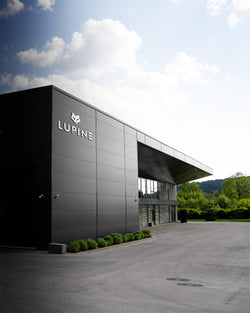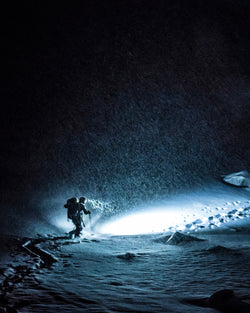History
2018
Lupine SL AF/ SL F: Intelligent light for the road
In 2018, we launched the SL F and SL AF, two groundbreaking lamps based on the SL A that redefined the boundaries between everyday use and high-end technology. The SL F, developed specifically for e-bikes, combined automatic daytime running lights, glare-free low beam, and powerful high beam – fully compliant with German road traffic regulations for the first time. The SL AF expanded the concept with full flexibility: as a battery-powered lamp with Bluetooth remote control and sensor-controlled automatic light control. Both models set new standards in safety, ease of use, and light quality – intelligent, powerful, and uncompromisingly well-designed.
2017
Lupine Blika: Compact all-rounder with 2100 lumens and innovative flexibility
In 2017, we introduced the Blika, a new all-round helmet lamp for multi-sport use that took performance, versatility, and technology to a new level. With a whopping 2,100 lumens at the time, the helmet and headlamp combined a powerful main light with innovative additional functions such as red and green light, a gentle reading light, a separately controllable spotlight, and the practical Lupine quick-change system – ideal for everything from mountain biking to climbing to ski touring.
2016
Lupine SL A: First StVZO lamp with glare-free low beam
After intensive development work, in 2016 we succeeded for the first time in combining Lupine's high lighting standards with the strict requirements of the German Road Traffic Licensing Regulations (StVZO). The result was groundbreaking: a wide, homogenous light pattern, sufficient power even off-road, and, for the first time, a glare-free low beam for maximum safety on the road. With this innovation, the Lupine SL series celebrated its premiere – and marked the beginning of a new era for anyone who doesn't want to miss out on genuine Lupine light on the road.
2016
Lupine Neo: Compact, lightweight and powerful
In 2016, we introduced a new generation of headlamps to our range: the Neo, the smallest possible in size, with maximum practical performance. Despite its low weight of just 50 grams, the Neo impressed with an impressive 700 lumens and a perfectly balanced light pattern consisting of a wide peripheral light and a focused spot. Equipped with the FrontClick system, FastClick battery holder, and modern thermal management, the Neo combined the versatility of a compact lamp with the performance of significantly larger models.
2015
The first rear light with intelligent brake light function
With the red light, we presented a truly pioneering product in 2015: probably the first rear light with integrated sensors and brake light function. The development team invested countless hours selecting the perfect components and fine-tuning the sensor values – with the goal of creating a system that responds reliably in every situation. The result: a rear light that thinks, reacts to every movement, and remains the benchmark for safety and innovation to this day.
2015
Lupine Wilma R: Next model with Bluetooth remote control
Following the successful introduction of radio remote control on the Betty R, the Wilma R was also equipped with this innovative technology. This gave the smaller model the same level of comfort and control previously reserved only for the top model.
2014
Lupine Betty R: Introduction of the Bluetooth remote control
The Betty R ushered in a new era of light control at Lupine. As our technology became increasingly compact, and the button and electronics moved directly into the housing of most models, a crucial question arose: How could operation from the handlebars remain as convenient as before? The answer was pure innovation – our then-top model, the Betty R, was the first light to be equipped with a wireless remote control. The next big step followed in 2016: We replaced wireless technology with Bluetooth – a solution that we have been continuously developing ever since.
2010
Lupine Piko: The first version of the revolutionary dual-lens lamp
The Piko was our first lamp with a dual-lens system: compact, unobtrusive on the helmet, yet with impressive light output. With its clever design, we laid the foundation for our absolute customer favorite. Small in size, big in performance – the Piko demonstrated early on that efficient technology, performance, and practical handling can go hand in hand.
2008
Move to the first company building
After years in the barn, it was time for the next big step: In 2008, we moved into our first company building. A logical step that reflected Lupine's success and growing market recognition. More space, more options, more innovation – the move was not just a change of scenery, but a milestone on our path to illuminating the world with first-class lighting.
2008
Lupine Tesla: LED lamp with reflector
With the Tesla, we created something truly unique: our first and only LED lamp with a hexagonal reflector. This focused the light into a powerful, clear beam and achieved 700 lumens. A flashlight version of the Tesla followed later.
2007
Switching to Li-Ion batteries
The advantages of modern lithium-ion batteries became increasingly clear: longer runtimes, higher performance, and a significantly longer service life. Therefore, in 2007, we switched completely to this pioneering technology – a decisive step for the next generation of our lamps. This marked the final departure from NiMh and NiCd batteries and from then on, we focused on power, efficiency, and innovation. RIP NiMh & NiCd – hello Li-Ion!
2007
Lupine Betty: Wilma's big sister
In 2007, we introduced the Betty, the Wilma's big sister. It followed the same innovative concept, but featured significantly more LEDs and thus noticeably more power, resulting in 1,400 lumens. The Betty stood for uncompromising brightness, perfect illumination, and the confidence to set new standards in the high-end segment. A milestone that marked our product range.
2005
Lupine Wilma: First LED lamp according to today's standards
The Wilma marked the beginning of a true revolution for us. It wasn't just a new lamp, but the first representative of a completely new generation. For the first time, we used an LED lens system we developed ourselves, which has now become the standard. Suddenly, light was no longer just bright – it was more even, powerful, and reliable than ever before. The Wilma demonstrated what was truly possible with LEDs and laid the foundation for everything we developed in the years that followed. For us, the lamp was a milestone full of emotions: the moment an idea became a real future. The Wilma was more than just technology – it was the beginning of our LED era. From 2005 to 2007, we were able to increase the light output from 380 to 830 lumens.
2004
Lupine Otto: The exotic in the range
The Otto was a very special model: a hybrid headlight that combined the proven 25W halogen technology of the Nightmare with an outer ring of 5mm LEDs. Offered from 2004 to 2006, the lamp was a bold attempt to combine the best of both worlds. Even back then, the Otto was an oddity—because in 2005, we launched the Wilma, our first true LED lamp meeting today's standards. Nevertheless, the Otto was an important experiment: It helped us understand the advantages and limitations of hybrid technology and paved the way for the logical step toward pure LED systems.
2002
Lupine Edison: First gas discharge lamp
In 2002, we launched the Edison, our first completely self-developed gas discharge lamp. With 16 watts and 900 lumens, it acted like a true floodlight—more powerful than anything available up to that point. We developed a completely new starter electronics and, for the first time, integrated complex protection electronics for the battery and lamp. A milestone that paved the way for the high-end lighting class.
2001
Use of the first Li-ion batteries
Back in 2001, we were one of the first manufacturers to use lithium-ion batteries – long before they became standard. While others still relied on nickel-metal hydride or nickel-cadmium cells, we were already taking advantage of the clear superiority of the new technology: more power, lower weight, longer runtime. Back then, processing was significantly more demanding and required complex electronics. But we mastered precisely these challenges and continue to benefit from this advantage today.
2000
Lupine Spelu/Stuby: The first pure LED lamp
With the Spelu and Stuby, we presented our first LED-based lamp – equipped with 26 LEDs and up to four watts of power. Even though the model wasn't a huge market success at the time, it gave us a decisive advantage: our comprehensive expertise in LED technology. Even then, we partially relied on modern Li-ion batteries and integrated indicator LEDs to display the light levels – innovations that laid the foundation for many subsequent successes. The Spelu and Stuby: a bold step that put us on a successful path to the future.
1994/1996
Lupine Nightmare/Babylu: The zenith of halogen lamps
The Nightmare marked the beginning of the next evolutionary stage of our halogen lamps. This model offered increased performance of up to 25 watts throughout its life cycle, setting new standards in brightness and illumination. Robust, reliable, and even more powerful than its predecessor – the Nightmare was proof that we are constantly refining our technology and constantly improving our performance. With the Babylu, we ended an era: It was the last lamp in our range with a halogen bulb. Shortly thereafter, we turned our attention firmly to the future of lighting with state-of-the-art LED technology.
1991 - Lupine Passubio: First series-ready halogen lamp
Named after the Italian mountain range with its 52 tunnels, the Passubio represented pioneering spirit from the very beginning. Its high-end light source was encased in a housing milled from a single piece of aluminum – robust, elegant, and uncompromisingly high quality. It was operated via a clever cable button that could be easily attached to the handlebar thanks to Velcro. Even more revolutionary, however, was the patented O-ring handlebar mount: an innovation from Lupine that was unique at the time and is now copied by many competitors. The Passubio – a milestone that set the standard for modern bike lighting.
The products available at the time had the characteristics of flashlights! A uniform, bright light surface? None!
- Wolf-Dieter Koch, founder
1989
Founding
In the winter of 1989, a few friends were mountain biking through Bavaria's forests – for Wolf, the company founder, they were simply too dark. This is precisely where the Lupine story began in 1989. Wolf wanted more: not a dim light, but a lamp truly made for mountain bikers and outdoor enthusiasts. Since such a thing didn't exist, and the few alternatives were unaffordable or difficult to obtain, he quickly developed his own solution. What emerged back then from the desire for more and interest in new technology remains our driving force to this day: We don't think in terms of budgets, but in terms of possibilities. We define what a lamp must achieve and then build it precisely to that end – without any cuts or compromises. The result? Products that often seem far removed from any economic rationale, yet set standards. Because at Lupine, it's all about the best light – with perfect, uniform illumination and uncompromising quality – Made in Germany!




















